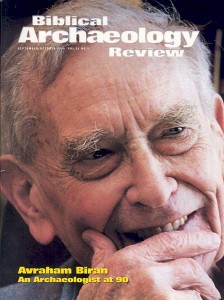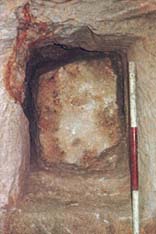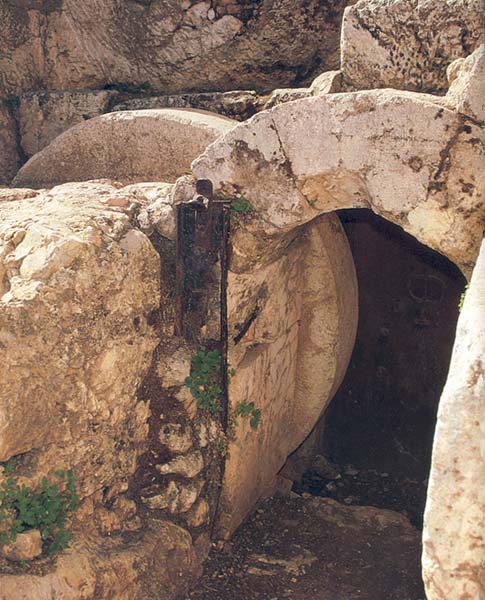
We should have a very good idea what Jesus’ tomb looked like, with the references in the Gospels and our knowledge of contemporaneous tombs found in and around Jerusalem. Yet until now, most of the reconstructions of this most famous of tombs have, I believe, been wrong.
The most surprising of my findings is that the blocking stone in front of the tomb was square, not round. So it could not, as many New Testament translations have it, be “rolled away”; it could only be pulled back or away.
As we shall see, the archaeological evidence for my new reconstruction is clear enough. The gospel texts, however, will need some explaining.
Let’s begin at the entrance to the tomb. It is true that the massive blocking stones (in Hebrew, golalim; singular, golel or golal) used to protect the entrances to tombs in Jesus’ day came in two shapes: round and square. But more than 98 percent of the Jewish tombs from this period, called the Second Temple period (c. first century B.C.E. to 70 C.E.), were closed with square blocking stones. Of the more than 900 burial caves from the Second Temple period found in and around Jerusalem, only four are known to have used round (disk-shaped) blocking stones.
Jerusalem tombs in this period were typically family tombs carved into the limestone caves found throughout the region. The entrances to the most common type of burial caves were generally rectangular (nearly square in shape) and low. Inside, steps led down into a rectangular standing pit that was lined on all but the entrance side by benches. This standing pit, created by digging out the floor, allowed ancient workmen to stand erect in the low-ceilinged cave. Two kinds of recesses were carved into the cave walls for individual corpses: deep cavities, about 6 feet deep and 1.5 feet wide and high, called loculi (kochim in Hebrew); and shallow shelflike niches, about 6 feet long. These shallower niches are called arcosolia if the top of the niche is arched and quadrosolia if the niche is rectangular, with a straight top. About a year after the primary burial in one of these recesses, after the body had decomposed, the bones were reburied in a bone storage chamber or, during the first century C.E., in a stone ossuary, or bone box.
As more space was needed in the tomb, additional burial niches were carved into the limestone walls. In more elaborate tombs, room after room might be added to the cave, extending it in various directions.a
The blocking stones that covered the entrance were believed to prevent ritual impurities within the tomb from escaping. They also kept scavenging animals from entering.
Square or rectangular blocking stones sealed the entrance of a cave tomb much like a cork in a bottle: One end of the blocking stone fit snugly into the entrance while the other end, like the top of a cork, was somewhat larger on the outside. Sometimes the blocking stone was supported by other stones, called in the Mishnahb dofek (the stone closer to the golel) and dofek dofkin (the outer stone).1
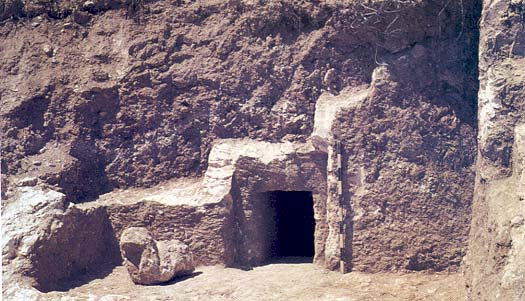
The handful of round blocking stones from Jerusalem in this period are large, at least 4 feet in diameter. They occur only in the more elaborate cave tombs, which had at least two rooms or, as in one case, a spacious hall. The most famous example comes from the so-called Tomb of Herod’s Family, which can still be seen behind the King David Hotel in Jerusalem.2 Another very well known example is from the so-called Tombs of the Kings, which is actually the tomb of Queen Helena of Adiabene, located north of the Old City of Jerusalem, near the American Colony Hotel.3 Both of these tombs are elegant and rich. The third example comes from a funerary monument adjacent to the Tomb of Herod’s Family.4 The fourth is from an elaborate tomb in the Kidron Valley.5 In addition, a small round sealing stone was probably used to close off the inner rooms in a tomb in the Hinnom Valley, but it was not used in the entryway.6 These round stones, which were set on one end between two parallel walls and thus moved on a sort of track, not only provided a good seal but could easily be rolled away to open the tomb for new interments or secondary burials.
So far we have been talking about blocking stones from the Second Temple period, which ended with the Roman destruction of Jerusalem in 70 C.E. In later periods the situation changed, and round blocking stones became much more common. Dozens of them have been found from the late Roman to Byzantine periods (second to seventh century C.E.). These later round stones were much smaller than the Second Temple period stones (less than 3 feet in diameter), and they did not move on a track but simply leaned against the rock facade, making them even simpler to move.7
But in Jesus’ time, round blocking stones were extremely rare and appeared only in the tombs of the wealthiest Jews. Nevertheless, the Gospels seem to indicate that Jesus’ tomb was sealed with a rolling stone. As quoted in the box on page 24, all four canonical Gospels refer to Jesus’ tomb. Matthew, Mark and Luke all describe the stone being “rolled” (in John it is “taken away”), and thus it is only natural to assume that the stone was round. But we must remember that “rolled” is a translation of the Greek word kulio, which can also mean “dislodge,” “move back” or simply “move.” This ambiguity in the text, combined with the archaeological evidence, leads me to agree with the scholar Gustave Dalman, who, as early as 1935, suggested that Matthew 27 does not refer to a round blocking stone.
In Matthew 28 an angel sits on the stone after “rolling” it back. If the stone had been rolled back between two walls, as was the case with Second Temple period round stones, it would have been impossible to sit on it. Indeed, it would be difficult to sit on the edge of a disk-shaped stone even if it had been pulled back from the tomb entrance. A square blocking stone would make a much better perch. Of course, with angels anything can happen, but it seems likely that the human author of the Gospel would have described the angel sitting on a square stone.
It may be worthwhile returning for a moment to the Hebrew word for these blocking stones, both round and square: golal or golel (plural, golalim). The root means “to roll” as well as “to move.”
Now let us try to picture the interior of the tomb in which Jesus was buried. That the tomb was small is suggested by the fact that the corpse could easily be seen from the entrance: Mary Magdalene and another woman named Mary could apparently see the body from outside (Mark 15:47; see also John 20:1).
According to most earlier reconstructions, Jesus’ tomb had an entrance corridor. On either side were burial niches (either arcosolia or quadrosolia), in one of which Jesus was supposedly laid. But here again archaeological evidence suggests otherwise. In the Second Temple period, the only tombs with burial niches in the entry corridors were large burial complexes such as the Tombs of the Kings8 and a tomb in the Hinnom Valley called Firdus e-Rum, known traditionally as the tomb of St. Onofrius.9 But not one of the hundreds of one-room Second Temple tombs has an entry passage with quadrosolia or arcosolia.
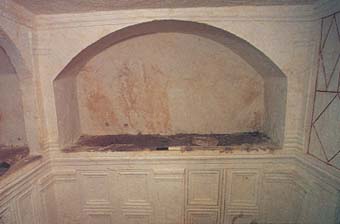
The gospel text also indicates that Jesus was not laid on a quadrosolium or arcosolium. In John 20:12 Mary sees two angels “sitting where the body of Jesus had lain, one at the head and the other at the feet.” This would have been impossible (or unlikely) if the body had been laid in a burial niche, because arcosolia and quadrosolia were at most 2 feet high.10
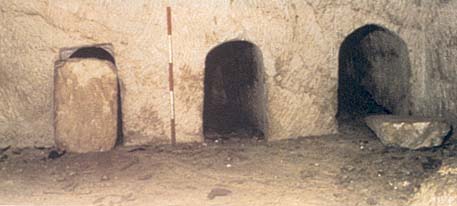
Most likely Jesus’ tomb was a standard small burial room, with a standing pit and burial benches along three sides. It may or may not have had loculi. Scholars who have studied burial caves from Second Temple times have concluded that primary burials were often performed in small, hastily dug burial caves—and only later were loculi, arcosolia and bone storage chambers, or additional rooms added.
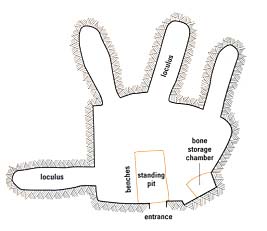
Jesus’ burial took place on the eve of the Sabbath. His would have been a hurried funeral, in observance of the Jewish law that forbade leaving the corpse unburied overnight—especially on the Sabbath and religious holidays. The body was simply and hastily covered with a shroud and placed on a burial bench in a small burial cave. This is the context in which we should understand John 20:11, in which we are told that Mary “bent over to look into the tomb,” and saw two angels sitting at the head and foot of where Jesus’ body had lain.
I would go one step further and suggest that Jesus’ tomb was what the sages refer to as a “borrowed (or temporary) tomb.” During the Second Temple period and later, Jews often practiced temporary burial. This is reflected, for example, in two quotations from rabbinic sources involving burial customs and mourning:
Whosoever finds a corpse in a tomb should not move it from its place, unless he knows that this is a temporary grave.11
Rabbi Simeon ben Eleazar says: “Rabban Gamliel had a temporary tomb in Yabneh into which they bring the corpse and lock the door upon it … ”12
A borrowed or temporary cave was used for a limited time, and the occupation of the cave by the corpse conferred no rights of ownership upon the family.
Jesus’ interment was probably of this nature. He was buried hurriedly on Friday, on the eve of the Sabbath. On the third day, the day after the Sabbath, Mary Magdalene and another Mary visited the tomb, as was the Jewish custom.13 (The counting of the days, incidentally, also follows Jewish custom, which included both the first and the last day in the count. To this day, circumcision of Jewish boys occurs on the eighth day, counting the day of birth as day one; a son born on a Monday, for example, is circumcised on the following Monday.)
According to Jewish tradition, the purpose of the visit to the tomb after three days was to determine the condition of the corpse:
One should go to the cemetery to check the dead within three days, and not fear that such smacks of pagan practices. There was actually one buried man who was visited after three days and lived for twenty-five more years and had sons, and died afterward.14
Jesus’ disciples may have visited the tomb on the third day to conform to this Jewish custom. But by that time, he had risen.
Scholars generally agree that the site of the Holy Sepulchre Church marks the location of Jesus’ burial.c But the aedicule (shrine) inside the church, which marks the traditional burial site, bears no signs of a first-century burial. The burial shelf in the aedicule is covered with a later slab, which does not appear to be part of the local bedrock and was probably imported into the cave.15 Until recently, only the bench on the right side of the aedicule was thought to have been original. (The aedicule itself dates to the beginning of the 19th century.) Recent studies at the site, however, have not shed light on the relationship between the rock, the foundations and the aedicule as they exist today and the original burial cave.16 The only indication that the spot where the aedicule now stands might once have been a tomb is the presence of a burial cave with loculi a few yards away.17
Jesus’ tomb may no longer exist. But through a combination of archaeological research and textual study, we may still reconstruct its original appearance, starting with the square stone that blocked its entrance.

